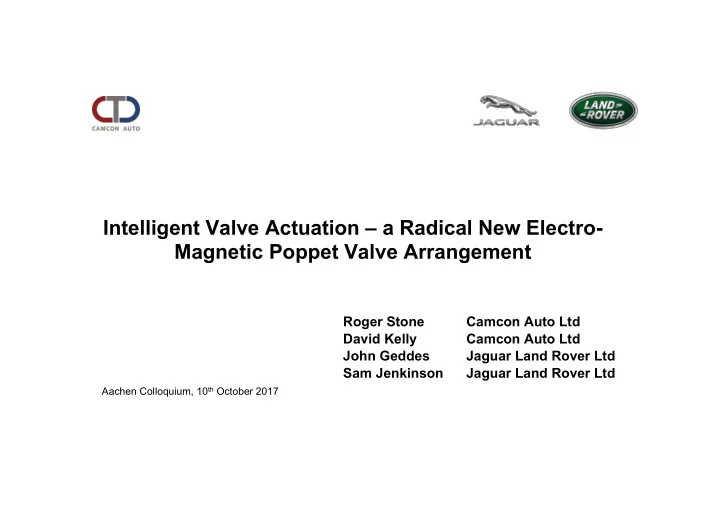

Intelligent Valve Actuation – a Radical New Electro- Magnetic Poppet Valve Arrangement Roger Stone Camcon Auto Ltd David Kelly Camcon Auto Ltd John Geddes Jaguar Land Rover Ltd Sam Jenkinson Jaguar Land Rover Ltd Aachen Colloquium, 10 th October 2017
What is IVA? • IVA is a full authority, purely electro-mechanical, variable valve actuation system for piston engines • Unprecedented level of control – valve by valve • Full, fast feedback control throughout the event • Can be used on both inlet and exhaust valves, double events possible – an HCCI enabler? • Digital control of gas exchange, the last controllable combustion variable
Intelligent Valve Actuation • Uses an individual, electrically actuated desmodromic mechanism per valve or valve pair • No mechanical drive from the crankshaft • No conventional valve (or “helper”) spring • Compliance to allow for seating loads, expansion etc. is built in to the drop link • Operates on 12 or 48 volts
Operating Modes • Full lift = full rotor rotation • Part lift = part rotation + return • Rotor velocity never constant • Rotor “parks” between most events • Every event is independent of both its predecessor and its successor
What Does IVA Offer? • Individual control over every valve, every cycle • Complete, infinitely variable, phase control • Complete, infinitely variable, period control • Complete, infinitely variable, lift control • Event shape control – and not just MOP shift • All virtually independent of each other • Multiple event, no event • All from one valve event to the next
IVA Installation IVA Electronic Control Unit • Actuator axis perpendicular to crankshaft • Electronic control unit compliantly mounted over or alongside the mechanicals • Packages within normal N-S and E-W layouts with conventional bonnet clearances Actuator IVA Actuator Rotor/Camshaft Module
Electro-Mechanical Layout • Mechanically, the linkage contains nothing unfamiliar or of unusual precision • Each actuator is an 8-pole, permanent magnet machine • The stator is segmented and shared between actuators, maximising torque capacity and efficiency • Asymmetry further improves performance/unit package volume and weight Actuator Rotor Centre End view of 8 valve stator laminate stack showing asymmetric slots for windings and the 4 different segment geometries
Control • Master controller requests the required valve event • Each actuator is under independent position control • Local actuator controller determines the target rotor trajectory for minimal energy consumption • The target trajectory is dynamically adjusted, compensating for transient engine behaviour during each valve event
Testing • Testing has been conducted both on test rigs and on the dynamometer • The first IVA modules have been designed for the inlet valves of a Jaguar Land Rover Ingenium engine • Successful completion of 500 hour OEM durability cycle on the rig • >1200 hours on the engine dyno
Engine Performance Baseline Inlet IVA • Max valve lift reduced to 7.8mm engine Results • 1D analysis suggested similar performance- timing/period compensating for reduced lift • The dynamometer results confirmed the NB: No full load work below predicted performance 1500 RPM attempted at this stage • Maintains engine performance at the same boost level • Reduces IVA electrical power demand • Eliminates piston interference
Dynamometer Testing Sample results for 2.62 bar/1500RPM point • 10 “minimap” steady state points defined • Large DoE experiment completed (Inlet only) • CO 2 improvements up to 7.5% recorded • Optimised events established • The VVT capability required is greater than any other available system • Even greater IVA dynamic capability is now in development and will provide further benefit
Results Analysis Upper bounds of conventional Lower bounds of conventional valve train friction valve train friction • The CO 2 benefits come from Current IVA Current IVA 3 sources: power demand & power demand corresponding • Pumping loss alternator drive power • Heat release rate & knock sensitivity IVA power demand at Minimap points • Parasitic losses Next generation IVA • power demand CO 2 results achieved with IVA power sourced from the alternator – opportunity for IVA Power Demand vs Conventional Valve Trains smart charging?
Event Consistency • Valve position was measured on the fired engine for 300 consecutive events • An example of the control achieved is shown • Measurements of event quality have been established in order to ensure that other development improvements, e.g. power consumption, can be measured against a common standard
Optimised Events • Throttle wide open in all cases, including idle • Single valve mode often best • Both EIVC and LIVC capability needed for different conditions • Late MOP useful for some events • Only steady state and the simplest IVA strategies have been explored so far – there is much more to come
Other Aspects of Note • VERY low mechanical noise • Transient valve response: 0-100% in one cycle • Significant detonation sensitivity improvement • Cranking torque reductions of ~30% through reduced pumping loss have been demonstrated • There are hybridisation synergies yet to be explored but deletion of the timing drive is an obvious benefit • Demo car available now • Single cylinder R&D programme support possible
Cost and Affordability • On-costs have been estimated as a joint effort – a Tier 1, Jaguar Land Rover and Camcon: • The CO 2 benefit, even on the basis of today’s steady state results alone “pays for” the system • There is much more to come in terms of CO 2 benefits Inlet IVA only: Cost-Benefit
Next steps • The next generation IVA prototypes are being procured now. • The new actuators will be smaller, lighter, cheaper, >40% lower electrical power demand • Improved dynamic performance will mean further improved CO 2 results • Exhaust actuators and 16V engine testing included in the next stage of the programme Today’s Next Generation – • Prototype Running in Q1 2018 And then: diesel, including heavy duty
Thank you very much, questions?
Recommend
More recommend